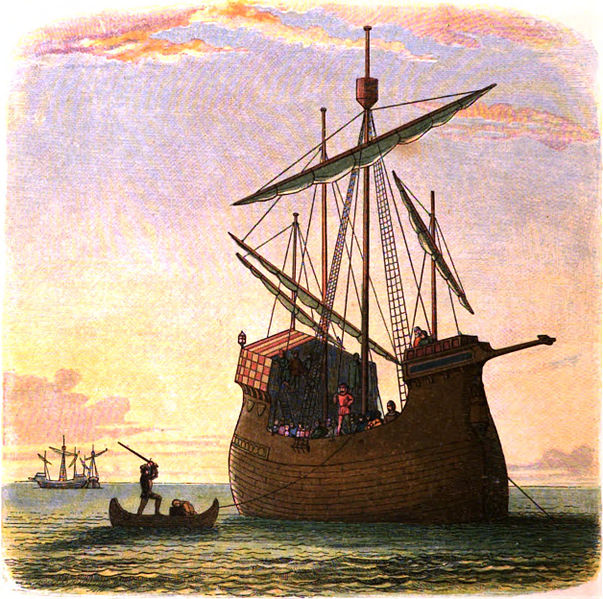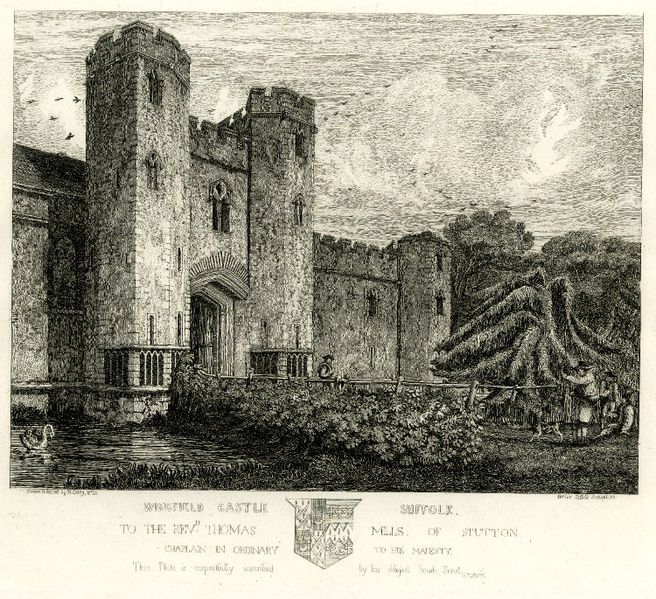
Rightly or wrongly, William de la Pole, 1st Duke of Suffolk was blamed for the loss of English territory in France, fiscal mismanagement, civil unrest and the general overall troubles of the reign of King Henry VI of England. He was arraigned on many charges and put in the Tower. Parliament was at the ready to put Suffolk on trial and in all likelihood would have found him guilty and he would have been executed. But Suffolk was the head of the court party that ruled for the weak king Henry and his Queen Margaret of Anjou. They both wanted to do everything they could to spare him the death penalty.
Henry told Parliament he would utilize his prerogative as King and he would decide the fate of Suffolk. The Duke vigorously denied all the charges. Henry dithered and delayed making a decisive pronouncement and finally, at the urging of Queen Margaret, he decreed that Suffolk should be banned from England for five years beginning May 1, 1450, probably in the hope that the governmental difficulties would die down, allowing him to return.
The Lords of Parliament probably agreed with this decision but the common people were furious. It was not in the Lords’ best interests to put a powerful magnate like themselves on trial just to please the populace. The Duke was accompanied away from Westminster during the night of March 19th heading for his house at St. Giles. He was pursued by a party of outraged Londoners who tried to enter the house by force with the intention of lynching him. He managed to escape out of a back door. The infuriated crowd seized Suffolk’s horse and attacked his servants.
Suffolk took refuge in his castle of Wingfield in Suffolk. During the next six weeks, news of his banishment spread and angered the public even further. During this time he wrote an emotional goodbye letter to his son. On April 29, the final session of Parliament met at Leicester and many were calling for the execution of Suffolk and other alleged “traitors”. The Duke sailed for exile from Ipswich for Calais on April 30 with two ships and a small pinnace. The pinnace was sent ahead with letters to trusted allies in Calais to determine if they would receive him.

Later in the day, Suffolk’s ship was intercepted in the straits of Dover by a small fleet of ships that had lain in wait for him. Included in this fleet was a ship called the Nicholas of the Tower. This was a large vessel of the royal fleet and was captained by Robert Wennington, a ship-owner from Dartmouth. Wennington knew Suffolk was coming after catching the pinnace and sent some of his men in a small boat to Suffolk. The men said Suffolk must speak with their master. Suffolk agreed, got into the small boat with two or three of his men and went to the Nicholas. When he got there, Wennington greeted him with “Welcome, Traitor!”
Over the next day, the crew subjected Suffolk a mock trial on the articles of impeachment and found him guilty. As his own ships watched, Suffolk was drawn out of the big ship into a smaller boat that held an axe and rusty sword. One of the coarsest of the sailors told Suffolk to lay down his head. He was told if he cooperated he would be dealt with fairly and die by the sword. The sailor then took the sword and cut off Suffolk’s head, taking half a dozen strokes to finish the deed. Although his murder was instigated by his political opponents, their identity has never been established.
The sailor removed the Duke’s gown of russet and his doublet of mailed velvet and the body was left on the sands of Dover. It’s possible his head was set on a pole next to the body. The body lay on the beach for some time until the king ordered it be removed. In June, his remains were taken to Wingfield church in Suffolk. Suffolk’s widow, Alice Chaucer informed Queen Margaret of her husband’s death. Margaret was devastated and spent the next three days weeping and unable to eat. Alice had him buried in the Carthusian Priory at Hull which has since been destroyed.
Suffolk’s death left a vacuum in the government which would be filled by Richard Plantagenet, Duke of York. Henry and Margaret and their supporters did not trust the Duke. At first, York was interested in getting rid of corruption and mismanagement in Henry’s government. But eventually he pressed his own claim to the throne of England. Parliament did name him as Henry’s heir but this decision alienated Queen Margaret because the result was the disinheritance of her son Edward of Lancaster, Prince of Wales. By gaining the Queen’s enmity, two factions emerged at court: the Lancastrians who supported King Henry VI, Queen Margaret and the Prince of Wales and the Yorkists who supported the Duke of York. The bloody fighting that ensued would become known as the Wars of the Roses.
Further reading: “The Wars of the Roses” by Alison Weir, entry in the Dictionary of National Biography on William de la Pole written by John Watt, “The Wars of the Roses” by Michael Hicks
[…] early as 1450, William de la Pole, 1st Duke of Suffolk considered Margaret’s royal blood and inheritance important enough to broker a marriage with his […]
LikeLike
I don’t know (of course), but always got the impression that poor old William got a raw deal. Certainly, he was a scapegoat.
LikeLiked by 1 person
[…] in that part of Wales gave the area a new, strong and stable regime which had been lacking since the death of the Duke of Suffolk in 1450. The king also made sure the brothers had a magnificent wardrobe to match their enhanced […]
LikeLike
[…] blamed for mismanaging the King’s government and was fighting for his political life. He was eventually murdered and Margaret’s wardship was returned to the king. In February of 1453, Margaret and her daughter […]
LikeLike
[…] to the incompetence of Edmund Beaufort, Duke of Somerset. This led directly to the disposition and murder of the Duke of Suffolk. The colossal loss of territory, the debt caused by the war, local grievances and concern for the […]
LikeLike
[…] ceremony but Margaret was returned to her mother and the marriage was never consummated. When Suffolk was disgraced in April of 1450, the marriage between Margaret and John de la Pole was voided. Margaret never referred to John de […]
LikeLike
[…] his son John. They were too young to consummate the marriage and Margaret remained with her mother. Suffolk was murdered in 1450 and Margaret’s wardship came back to the crown. There was little interest in her potential as an […]
LikeLike
[…] in protecting the rights of her husband and son. William de la Pole, 1st Duke of Suffolk came to a very bad end. Edward IV’s queen, Elizabeth Woodville and her family suffered greatly during the conflicts. The […]
LikeLike
I have always felt empathy for this poor man, and often wonder if the Duke of York had a hand in his death,
LikeLiked by 2 people
You have a good point about York, Paula. The ship that captured him was a royal vessel so someone in the government had something to do with it.
LikeLiked by 1 person
[…] Origen: The Death of William de la Pole, 1st Duke of Suffolk ~ Murder at Sea « The Freelance History Writer […]
LikeLike
Reblogged this on History's Untold Treasures and commented:
H/T Freelance History Writer
LikeLiked by 1 person